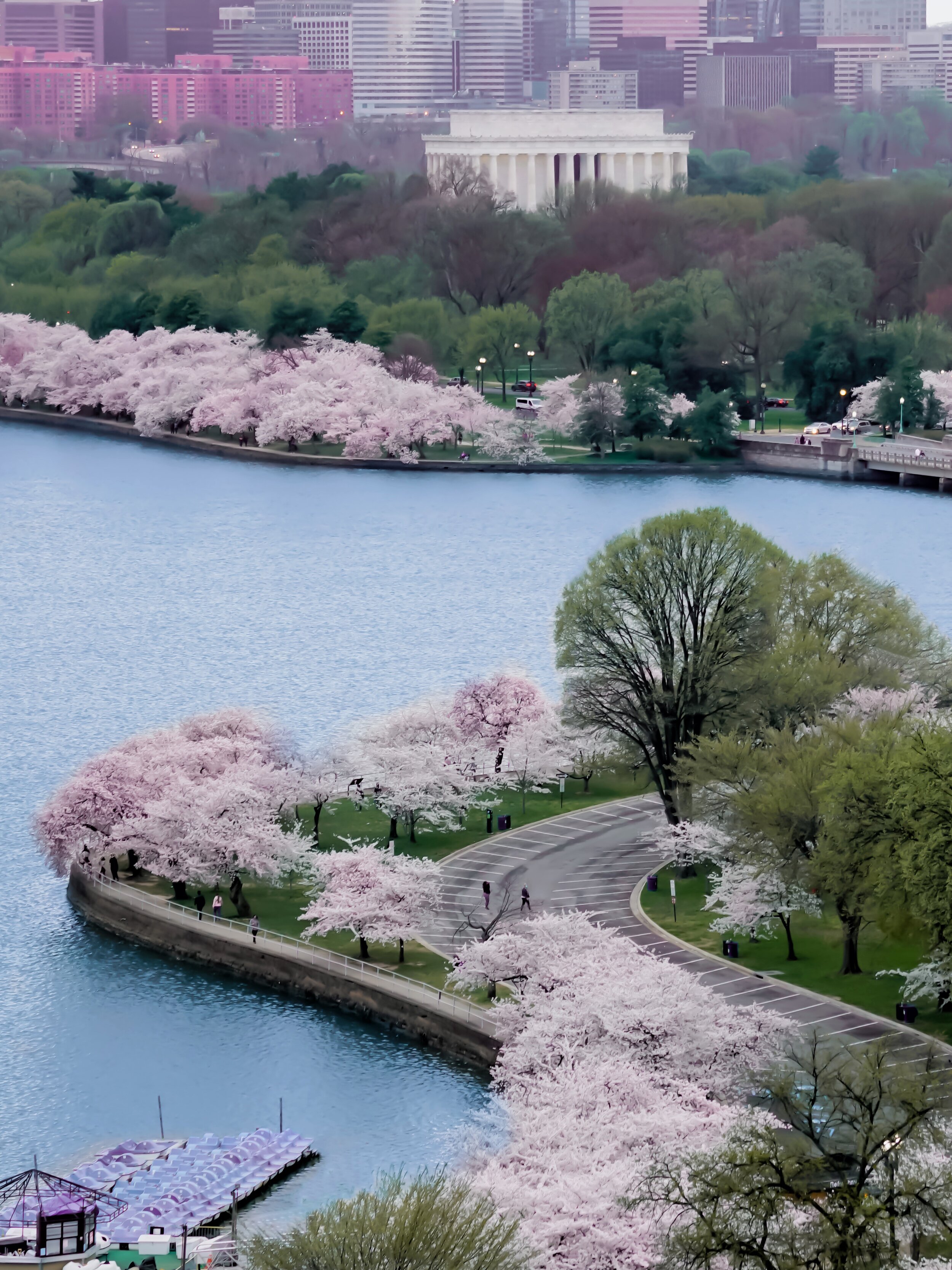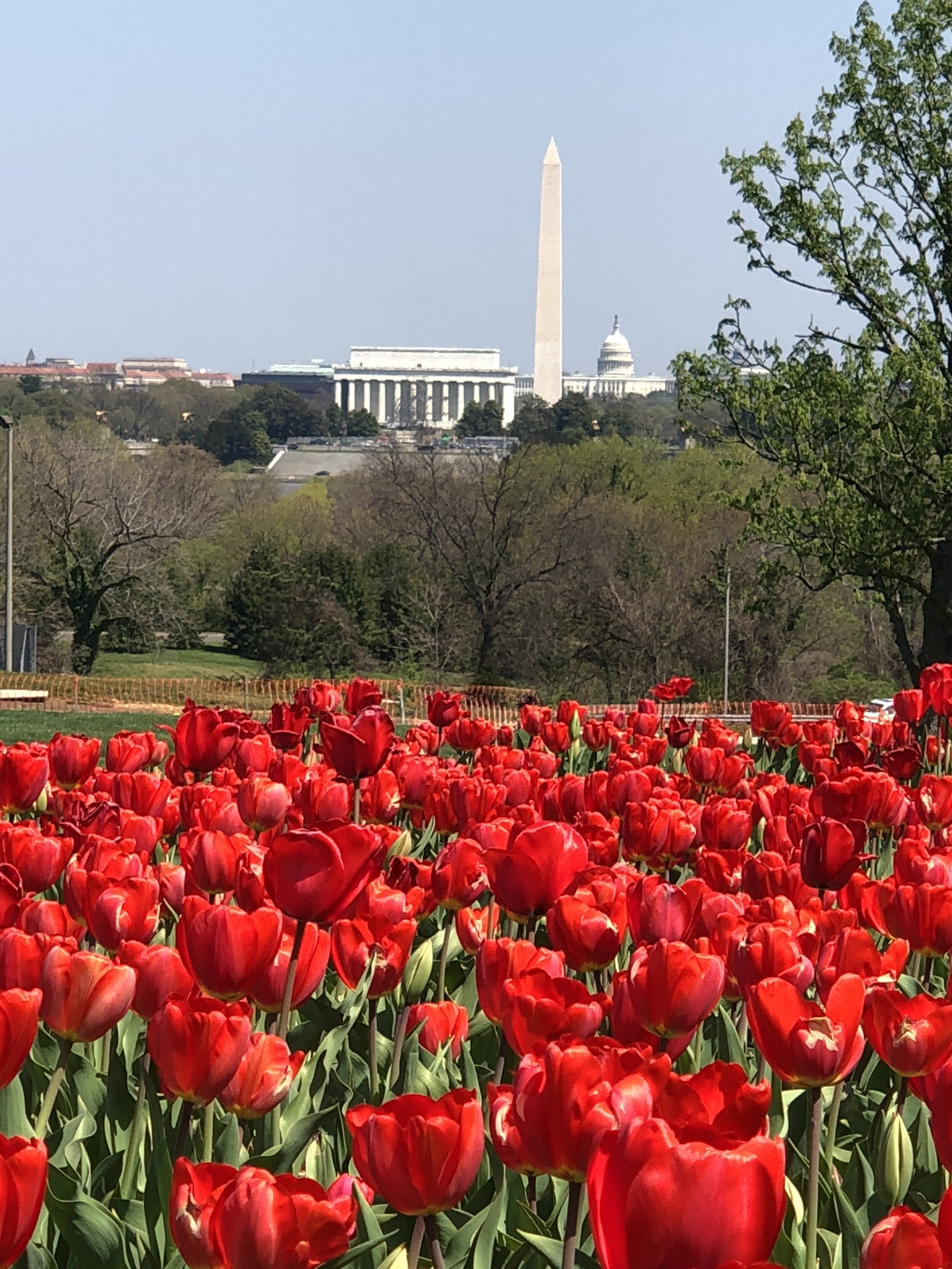Want to know where to photograph DC’s famous cherry blossoms and magnolias? Here are a few of my suggestions. Keep in mind during the pandemic, the Tidal Basin and US Capitol grounds will have boundary restrictions.
NO. 1
Tidal Basin
2021 Peak Bloom Prediction April 2‑5, 2021
On Tuesday, the National Park Service announced that it will be “limiting all vehicular and pedestrian access” around the Tidal Basin during the period in which most of the pink‑ and white‑petaled trees are blossoming because of the coronavirus pandemic. Access to parking lots and paddle boats will be shut down when the trees begin to blossom, the Park Service said — a loose time frame that could begin as soon as this weekend.
Officials said that blossom admirers will still have access to the Tidal Basin — until crowds swell past an acceptable limit.
Tidal Basin viewed from 1331 Maryland Ave SW
NO. 2
Rawlins Park
Located at 1900 East St. NW., and lined with magnolia trees on all four sides, Rawlins Park is an urban oasis, complete with an impressive statue of John Rawlins, former Secretary of War under President Ulysses S. Grant, two long reflecting pools, frequented by ducks, a calming fountain, and numerous park benches.
NO. 3
Martin Luther King, Jr. National Memorial
Just around a bend in the Tidal Basin from Franklin Delano Roosevelt Memorial stands the memorial to Dr. Martin Luther King, Jr. The memorial was designed as a home to an additional 182 cherry trees, emphasising Dr. King’s lifelong message of endurance and faith. Most years, the blooming period of the trees coincides with the anniversary of King’s April 4, 1968 assassination. The color, light, and beauty of the cherry trees adds a sense of renewed hope to a time of reflection and remembrance. The blossoms add visual complexity to the varied stone surfaces of the memorial and underscores Dr. King’s messages of courage and leadership engraved throughout the memorial. The blossoms also highlight the shrimp pink granite of the centerpiece of the memorial, the statue of Dr. King set into the “Stone of Hope”, making King literally vibrant.
NO. 4
Congressional Cemetery
Located at 1801 E Street, SE.
During the pandemic, this historic cemetery is closed to the public unless you are a member of the dog park or you can pay $10 to bring your dog.
UPDATE: check their website they are now open with some restrictions. 
Congressional Cemetery
NO. 5
Smithsonian Gardens
Independence Ave SW & L'Enfant Plaza SW
Covering over four acres, the Enid A. Haupt Garden is situated between the Smithsonian Castle and Independence Avenue and has provided a welcomed respite for Smithsonian visitors since it opened in 1987 as part of the redesigned Castle quadrangle. Composed of the Parterre, the Moongate Garden, and the Fountain Garden, the Haupt Garden’s design brings together the cultures and architecture of the surrounding museums and buildings.
Smithsonian Gardens / Enid Haupt Garden
NO. 6
NPS Floral Library
Also known as the Tulip Library, the Floral Library was established in 1969 as part of Lady Bird Johnson's Capital Beautification Project. The 'library' has 93 flower beds maintained by the National Park Service. These beds feature either tulips or annuals depending on the planting season. The flowers require up to 10,000 bulbs to be planted by hand each year.
It’s located right next to the Tidal Basin, next to the northern end of the Maine Ave parking lot (the opposite end of the parking lot from the paddle boats). If you’re trying to get your bearings, it’s on the corner of the Tidal Basin closest to the Washington Monument.
NO. 7
Netherlands Carillon
The Netherlands Carillon is in Virginia near Arlington National Cemetery.
During the spring, there’s a large flower garden at its base featuring, naturally enough, tulips. And you can hear the bells ringing in automated concerts throughout the day and chiming the hour.
NO. 8
Dumbarton Oaks
1703 32nd St NW
Dumbarton Oaks is the legacy of Robert and Mildred Bliss, philanthropists and collectors of art. The Garden, designed by renowned landscape gardener Beatrix Farrand, is an oasis within the city, including sixteen acres of terraced gardens and vistas, orchards and kitchen gardens, and a vast wilderness of meadows and wooded pathways.
As a public health precaution, the Museum and Garden are closed temporarily. All public events will be virtual.
NO. 9
United States National Arboretum
The National Arboretum has 446 acres with 9.5 miles of winding roadways and is located in the northeast section of Washington, DC, approximately ten minutes from the Capitol Building. There are two entrances: one at 3501 New York Avenue, NE, and the other at 24th & R Streets, NE, off of Bladensburg Road.
GARDENS
Single‑genus groupings include: azalea, boxwood, daffodil, daylily, dogwood, holly, magnolia, and maple. Major garden features include: aquatic plants, the Asian Collections, the Fern Valley Native Plant Collections, the Flowering Tree Collection, the Flowering Tree Walk, the Friendship Garden, the Gotelli Conifer Collection, the Introduction Garden, the National Bonsai & Penjing Museum, the National Capitol Columns, the National Grove of State Trees, and the National Herb Garden.
NO. 10
Washington National Cathedral
3101 Wisconsin Ave NW
The Cathedral Close, the 59 acres surrounding the Cathedral, provide a beautiful sanctuary year‑round. The grounds consist of cultivated gardens, including the Bishop’s Garden; the Olmsted Woods, an oak and beech forest; manicured lawns; a prayer path; and the landscaped grounds and athletic fields of the Cathedral schools.
NO. 11
LeDroit Park
LeDroit Park is a neighborhood in Washington, D.C. located immediately southeast of Howard University. Its borders include W Street to the north, Rhode Island Avenue and Florida Avenue to the south, Second Street NW to the east, and Howard University to the west
NO. 12
U.S. Capitol Building, Washington D.C.
The U.S. Capitol Grounds also offer more than 100 cherry blossom trees — both the Yoshino and Japanese Flowering varieties — for public enjoyment.
Most of the trees are found in the Upper and Lower Senate Parks. Some of the oldest and most impressive are located on the West Front of the U.S. Capitol and on the Second Street, SE, side of the Library of Congress Thomas Jefferson Building.
Magnolia, shadbush, dogwood and apple trees also adorn the U.S. Capitol Grounds with impressive and fragrant blooms. In addition, thousands of spring bulbs planted in flower beds throughout the Capitol campus sprout a riot of color, including tulips, hyacinths, crocus and daffodils.
US Capitol
NO. 13
National Council of Negro Womens Headquaters
633 Pennsylvania Ave NW
Founded in 1935 by Mary McLeod Bethune, the mission of the National Council of Negro Women is to lead, develop, and advocate for women of African descent as they support their families and communities. There purpose is to empower and inspire women of African descent to be the leaders and forerunner in society that they were created to be.












